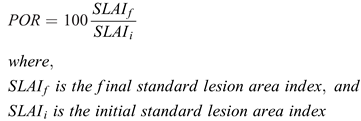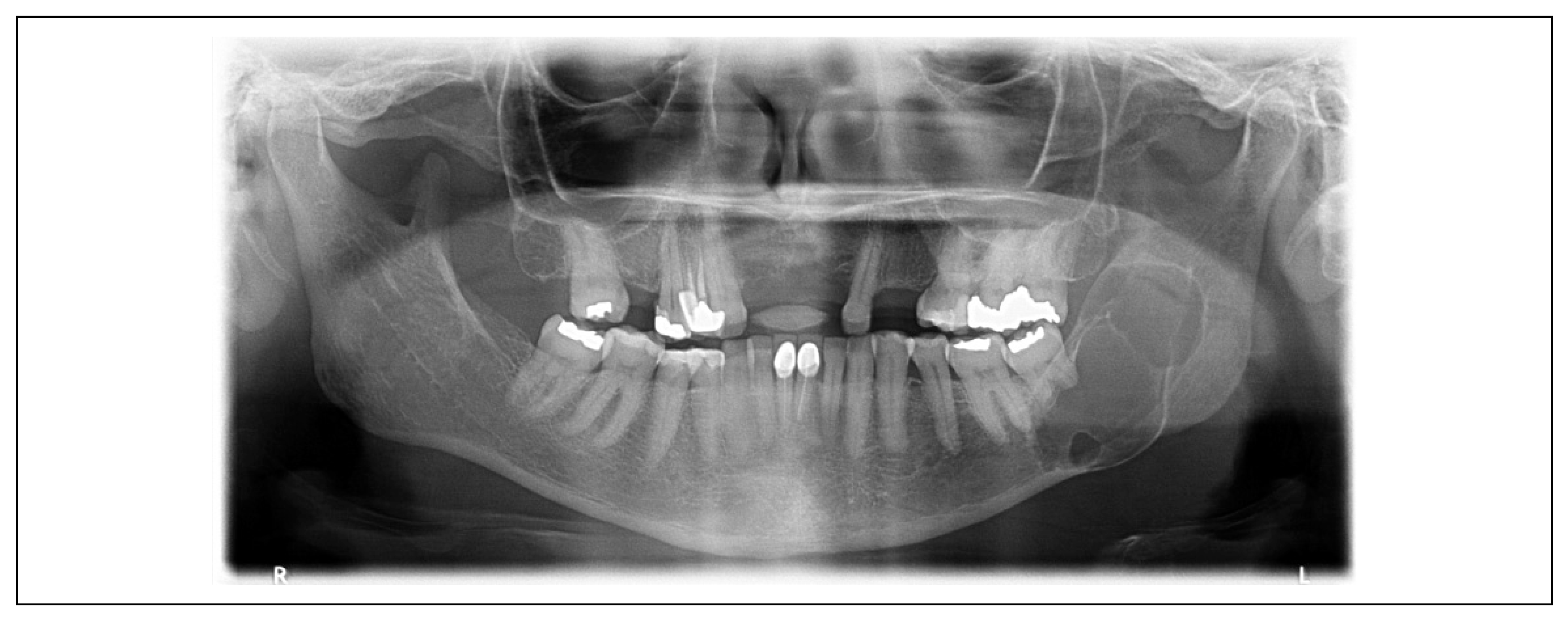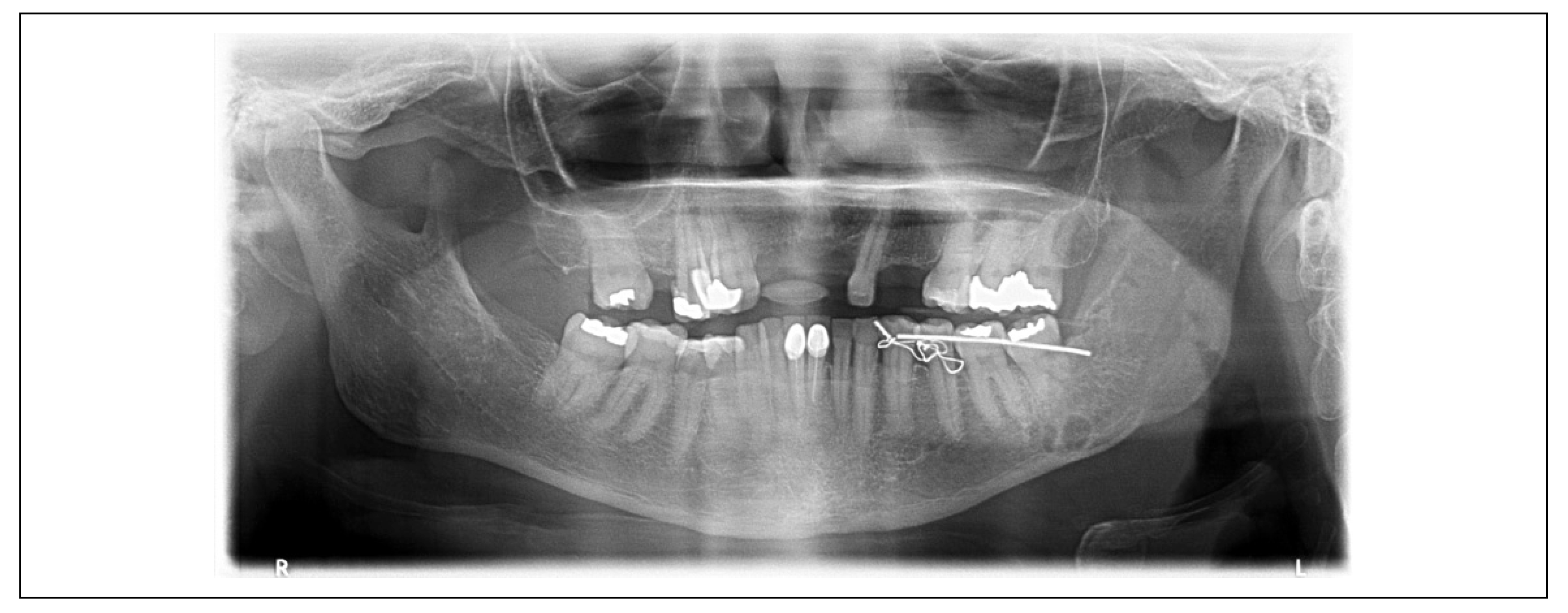Odontogenic Keratocyst: A Clinical Entity With Favorable Response to Active Decompression and Distraction Sugosteogenesis
Abstract
:Introduction
Materials and Methods
Type of Study and Data Collection


- 80-100% reduction: good reaction to treatment.
- 50-80% reduction: moderate reaction.
- 0-50% reduction: poor reaction.

Treatment Protocol
Results
Discussion
Funding
Acknowledgments
Conflicts of Interest
References
- Soluk-Tekkes¸in, M.; Wright, J.M. The World Health Organization classification of odontogenic lesions: a summary of the changes of the 2017 (4th) edition. Turk Patoloji Derg. 2018, 34, 1–18. [Google Scholar]
- Pogrel, M.A. The keratocystic odontogenic tumor. Oral Maxillofacial Surg Clin N Am. 2012, 25, 21–30. [Google Scholar]
- Williams, T.P.; Connor, F.A. Surgical management of the odontogenic keratocyst: aggressive approach. J Oral Maxillofac Surg. 1994, 52, 964. [Google Scholar] [CrossRef]
- Pogrel, M.A. Treatment of keratocysts: the case for decompression and marsupialization. J Oral Maxillofac Surg. 2005, 63, 1667. [Google Scholar]
- Pogrel, M.A. Decompression and marsupialization as a treatment for the odontogenic keratocyst. Oral Maxillofac Surg Clin N Am. 2003, 15, 415. [Google Scholar]
- Pogrel, M.A. Marsupialization as a definitive treatment for the odontogenic keratocyst. J Oral Maxillofac Surg. 2004, 62, 651. [Google Scholar]
- Toller, P.A. The osmolality of fluids from cysts of the jaws. Br Dent J. 1970, 129, 275. [Google Scholar]
- Blanas, N.; Freund, B.; Schwartz, M.; Furst, I.M. Systematic review of the treatment and prognosis of odontogenic keratocyst. Oral Surg Oral Med Oral Pathol Oral Radiol Endod. 2000, 90, 553. [Google Scholar]
- Castro-Núñez, J. An innovative decompression device to treat odontogenic cysts. J Craniofac Surg. 2016, 27, 1316. [Google Scholar]
- Castro-Núñez, J.; Rey, D.; Amaya, L. An innovative intracystic negative pressure system to treat odontogenic cysts. J Craniofac Surg. 2017, 28, 1883–1884. [Google Scholar]
- Castro-Núñez, J. Active intracystic negative pressure could induce osteogenesis. J Craniofac Surg. 2018, 29, e370–e371. [Google Scholar] [PubMed]
- Castro-Núñez, J. Distraction sugosteogenesis: its biologic bases and therapeutic principles. J Craniofac Surg. 2018, 29, 2088–2095. [Google Scholar] [PubMed]
- Moreno-Rodríguez, P.; Guerrero, L.M.; Gómez-Delgado, A.; Castro-Núñez, J. Active decompression and distraction sugosteogenesis for the treatment of calcifying odontogenic cyst. Oral Maxillofac Surg. 2020, 25, 89–97. [Google Scholar] [CrossRef] [PubMed]
- Anavi, Y.; Gal, G.; Miron, H.; Calderon, S.; Allon, D.M. Decompression of odontogenic cystic lesions: clinical long-term study of 73 cases. Oral Surg Oral Med Oral Pathol Oral Radiol Endod. 2011, 112, 164–169. [Google Scholar]
- Nakamura, N.; Mitsuyasu, T.; Mitsuyasu, Y.; Taketomi, T.; Higuchi, Y.; Ohishi, M. Marsupialization for odontogenic keratocysts: long-term follow-up analysis of the effects and changes in growth characteristics. Oral Surg Oral Med Oral Pathol Oral Radiol Endod. 2002, 94, 543–553. [Google Scholar]
- Gao, L.; Wang, X.L.; Li, S.M.; et al. Decompression as a treatment for odontogenic cystic lesions of the jaws. J Oral Maxillofac Surg. 2014, 72, 327–333. [Google Scholar]
- Partsch, C. Uber kiefercysten. Dtsch Mschr Zahnheilkd. 1892, 10, 271–304. [Google Scholar]
- Nakamura, N.; Higuchi, Y.; Tashiro, H.; Ohishi, M. Marsupialization of cystic ameloblastoma: a clinical and histopathologic study of the growth characteristics before and after marsupialization. J Oral Maxillofac Surg. 1995, 53, 748–754. [Google Scholar]
- Partsch, C. Zur behandlung der kieferzysten. Dtsch Mschr Zahnheilkd. 1910, 28, 252–260. [Google Scholar]
- Neuschmidt, V. Drainierungs-methode der kieferzysten. Dtsch Zahnärztl Wschr. 1942, 21, 287. [Google Scholar]
- Thomas, E.H. Cysts of the jaws; saving involved vital teeth by tube drainage. J Oral Surg. 1947, 5, 1–9. [Google Scholar] [PubMed]
- Oral Surgery, 3rd ed.Thoma, K.H. (Ed.) Mosby, 1958; pp. 1033–1036. [Google Scholar]
- Hu, Y.-J.; Li, S.-Y.; Xu, L.-Q.; et al. Clinical study of large mandibular odontogenic keratocyst treated by decompression. China J Oral Maxillofac Surg. 2005, 3, 229–232. [Google Scholar]
- Lizio, G.; Sterrantino, A.F.; Ragazzini, S.; Marchetti, C. Volume reduction of cystic lesions after surgical decompression: a computerized three-dimensional computed tomography evaluation. Clin Oral Invest. 2013, 17, 1701–1708. [Google Scholar] [CrossRef] [PubMed]
- Jeong, H.G.; Hwang, J.J.; Lee, S.H.; Nam, W. Effect of decompression for patients with various jaw cysts based on a three-dimensional computed tomography analysis. Oral Surg Oral Med Oral Pathol Oral Radiol Endod. 2017, 123, 445–452. [Google Scholar] [CrossRef]
- Consolo, U.; Bellini, P.; Melini, G.M.; Ferri, A.; Lizio, G. Analysis of marsupialization of mandibular cysts in improving the healing of related bone defects. J Oral Maxillofac Surg. 2020, 78, 1355.e1–1355.e11. [Google Scholar] [CrossRef]
- Tolstunov, L. Marsupialization catheter. J Oral Maxillofac Surg. 2008, 66, 1077–1079. [Google Scholar] [CrossRef]
- Kubota Y, Yamashiro T, Oka S, et al. Relation between size of odontogenic jaw cysts and the pressure of fluid within. Br J Oral Maxillofac Surg. 2004, 42, 391–395. [Google Scholar] [CrossRef]
- Chiapasco, M.; Rossi, A.; Motta, J.J.; Crescentini, M. Spontaneous bone remodeling after enucleation of large mandibular cysts: a radiographic computed analysis of 27 consecutive cases. J Oral Maxillofac Surg. 2000, 58, 942–948. [Google Scholar] [CrossRef]
- Swain LD, Cornet DA, Manwaring ME, et al. Negative pressure therapy stimulates healing of critical-size calvarial defects in rabbits. Bonekey Rep. 2013, 2, 1–8. [Google Scholar]



| Variables | Result |
| Patients (n = 6) | |
| Men | 5 (83.33%) |
| Women | 1 (16.66%) |
| Age (mean) | |
| General | 45.16 years |
| Range | 16-74 years |
| Presenting Signs and Symptoms | |
| Swelling | 2 (33.34%) |
| Tooth mobility | 1 (16.66%) |
| Pain | 3 (49.98%) |
| Abscess | 1 (16.66%) |
| Rhizolysis | 1 (16.66%) |
| Impacted tooth | 2 (33.34%) |
| Clinical cortical expansion | 1 (16.66%) |
| Cystic Characteristics | |
| Anatomic location | |
| Maxilla | 1 (16.66%) |
| Left Mandible | 3 (49.98%) |
| Right Mandible | 2 (33.34%) |
| Locularity | |
| Unilocular | 2 (33.34%) |
| Multilocular | 4 (66.66%) |
| Variables | Result |
| Patients (n = 6) | |
| Men | 5 (83.33%) |
| Women | 1 (16.66%) |
| Age (mean) | |
| General | 45.16 years |
| Range | 16-74 years |
| Presenting signs and symptoms | |
| Swelling | 2 (33.34%) |
| Tooth mobility | 1 (16.66%) |
| Pain | 3 (49.98%) |
| Abscess | 1 (16.66%) |
| Rhizolysis | 1 (16.66%) |
| Impacted tooth | 2 (33.33%) |
| Clinical cortical expansion | 1 (16.66%) |
| Cystic characteristics | |
| Anatomic location | |
| Maxilla | 1 (16.66%) |
| Left Mandible | 3 (49.98%) |
| Right Mandible | 2 (33.34%) |
| Locularity | |
| Unilocular | 2 (33.34%) |
| Multilocular | 4 (66.66%) |
| Complications | |
| Fistula development | 2 (33.32%) |
| Flap dehiscence | 1 (16.66%) |
| Intraoral unit | |
| Too big | 2 (33.34%) |
| No issues | 1 (16.66%) |
| iSLAI[14] | fSLAI[14] | Percentage of reduction in 2 weeks[14] | ||
| Patient | VLMAX × HLMAX | VLMAX × HLMAX | POR = SLAIf/SLAIi × 100 | Reaction to ADDS in 2 weeks[15] |
| 1 | 3.1 × 3.7 = 11.47 cm2 | 1.9 × 1.9 = 3.61 cm2 | 68.52% | Moderate reaction |
| 2 | 7.5 × 3.5 = 26.25 cm2 | 5.5 × 1.6 = 8.80 cm2 | 66.47% | Moderate reaction |
| 3 | 3.5 × 3.6 = 12.60 cm2 | 2.1 × 1.9 = 3.99 cm2 | 68.33% | Moderate reaction |
| 4 | 2.0 × 2.2 = 4.40 cm2 | 0.8 × 0.7 = 0.56 cm2 | 87.27% | Good reaction |
| 5 | 3.8 × 9.1 = 34.58 cm2 | 2.7 × 5.7 = 15.39 cm2 | 55.49% | Moderate reaction |
| 6 | 4.2 × 4.7 = 19.74 cm2 | 0.7 × 0.7 = 0.49 cm2 | 97.51% | Good reaction |
| Total | 18.17 cm2 | 5.47 cm2 | 73.93% | Moderate reaction |
© 2021 by the author. The Author(s) 2021.
Share and Cite
Porte, J.-P.; Guerrero, L.M.; Rivera, B.; Wiscovitch, A.; Castro-Núñez, J. Odontogenic Keratocyst: A Clinical Entity With Favorable Response to Active Decompression and Distraction Sugosteogenesis. Craniomaxillofac. Trauma Reconstr. 2022, 15, 268-274. https://doi.org/10.1177/19433875211035237
Porte J-P, Guerrero LM, Rivera B, Wiscovitch A, Castro-Núñez J. Odontogenic Keratocyst: A Clinical Entity With Favorable Response to Active Decompression and Distraction Sugosteogenesis. Craniomaxillofacial Trauma & Reconstruction. 2022; 15(4):268-274. https://doi.org/10.1177/19433875211035237
Chicago/Turabian StylePorte, Juan-Pablo, Lidia M. Guerrero, Bonifacio Rivera, Andres Wiscovitch, and Jaime Castro-Núñez. 2022. "Odontogenic Keratocyst: A Clinical Entity With Favorable Response to Active Decompression and Distraction Sugosteogenesis" Craniomaxillofacial Trauma & Reconstruction 15, no. 4: 268-274. https://doi.org/10.1177/19433875211035237
APA StylePorte, J.-P., Guerrero, L. M., Rivera, B., Wiscovitch, A., & Castro-Núñez, J. (2022). Odontogenic Keratocyst: A Clinical Entity With Favorable Response to Active Decompression and Distraction Sugosteogenesis. Craniomaxillofacial Trauma & Reconstruction, 15(4), 268-274. https://doi.org/10.1177/19433875211035237




